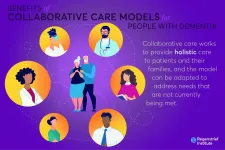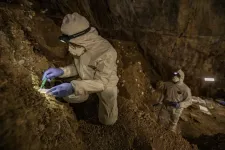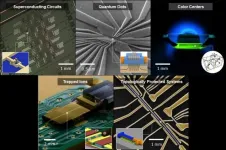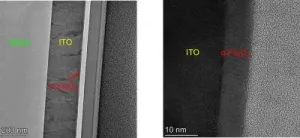(Press-News.org) COLUMBUS, Ohio - Someday, scientists believe, tiny DNA-based robots and other nanodevices will deliver medicine inside our bodies, detect the presence of deadly pathogens, and help manufacture increasingly smaller electronics.
Researchers took a big step toward that future by developing a new tool that can design much more complex DNA robots and nanodevices than were ever possible before in a fraction of the time.
In a paper published today (April 19, 2021) in the journal Nature Materials, researchers from The Ohio State University - led by former engineering doctoral student Chao-Min Huang - unveiled new software they call MagicDNA.
The software helps researchers design ways to take tiny strands of DNA and combine them into complex structures with parts like rotors and hinges that can move and complete a variety of tasks, including drug delivery.
Researchers have been doing this for a number of years with slower tools with tedious manual steps, said Carlos Castro, co-author of the study and associate professor of mechanical and aerospace engineering at Ohio State.
"But now, nanodevices that may have taken us several days to design before now take us just a few minutes," Castro said.
And now researchers can make much more complex - and useful - nanodevices.
"Previously, we could build devices with up to about six individual components and connect them with joints and hinges and try to make them execute complex motions," said study co-author Hai-Jun Su, professor of mechanical and aerospace engineering at Ohio State.
"With this software, it is not hard to make robots or other devices with upwards of 20 components that are much easier to control. It is a huge step in our ability to design nanodevices that can perform the complex actions that we want them to do."
The software has a variety of advantages that will help scientists design better, more helpful nanodevices and - researchers hope - shorten the time before they are in everyday use.
One advantage is that it allows researchers to carry out the entire design truly in 3D. Earlier design tools only allowed creation in 2D, forcing researchers to map their creations into 3D. That meant designers couldn't make their devices too complex.
The software also allows designers to build DNA structures "bottom up" or "top down."
In "bottom up" design, researchers take individual strands of DNA and decide how to organize them into the structure they want, which allows fine control over local device structure and properties.
But they can also take a "top down" approach where they decide how their overall device needs to be shaped geometrically and then automate how the DNA strands are put together.
Combining the two allows for increasing complexity of the overall geometry while maintaining precise control over individual component properties, Castro said.
Another key element of the software is that it allows simulations of how designed DNA devices would move and operate in the real world.
"As you make these structures more complex, it is difficult to predict exactly what they are going to look like and how they are going to behave," Castro said.
"It is critical to be able to simulate how our devices will actually operate. Otherwise, we waste a lot of time."
As a demonstration of the software's ability, co-author Anjelica Kucinic, a doctoral student in chemical and biomolecular engineering at Ohio State, led the researchers in making and characterizing many nanostructures designed by the software.
Some of the devices they created included robot arms with claws that can pick up smaller items, and a hundred nanometer-sized structure that looks like an airplane (The "airplane" is 1000 times smaller than the width of a human hair).
The ability to make more complex nanodevices means that they can do more useful things and even carry out multiple tasks with one device, Castro said.
For example, it is one thing to have a DNA robot that, after injection into the bloodstream, can detect a certain pathogen.
"But a more complex device may not only detect that something bad is happening, but can also react by releasing a drug or capturing the pathogen," he said.
"We want to be able to design robots that respond in a particular way to a stimulus or move in a certain way."
Castro said he expects that for the next few years, the MagicDNA software will be used at universities and other research labs. But its use could expand in the future.
"There is getting to be more and more commercial interest in DNA nanotechnology," he said. "I think in the next five to 10 years we will start seeing commercial applications of DNA nanodevices and we are optimistic that this software can help drive that."
INFORMATION:
Joshua Johnson, who received his PhD at Ohio State in biophysics, was also a co-author of the paper.
The research was supported by grants from the National Science Foundation.
Contact: Carlos Castro, Castro.39@osu.edu
Written by Jeff Grabmeier, 614-292-8457; Grabmeier.1@osu.edu
BRAZZAVILLE, Republic of Congo (April 19, 2021) - A new study classifies different types of wildlife traffickers and sellers in two of Central Africa's growing urban centers, providing new insight into the poorly understood urban illegal wildlife trade. The findings can help conservation and law enforcement authorities prioritize their efforts on professional criminals, identify patterns among repeat offenders, and determine if wildlife offenders are engaging in other types of crime.
Authors from the University of Maryland and Wildlife Conservation Society (WCS) describe their findings ...
INDIANAPOLIS -- A new report from the National Academies of Sciences, Engineering, and Medicine (National Academies) details the state of dementia care and research in America and provides guidance on future research to make sure both patients and their families are having their needs met by the care they receive. Sections of the report highlight the effectiveness of the collaborative care model as well as successful implementation, citing research from Regenstrief Institute, Eskenazi Health and the Indiana University School of Medicine.
There are between 3.7 million and 5.8 million people living with dementia ...
Scientists have sequenced ancient DNA from soil for the first time and the advance will transform what is known about everything from evolution to climate change.
The findings have been described as the 'moon landings' of genomics because researchers will no longer have to rely on finding and testing fossils to determine genetic ancestry, links and discoveries - and it is thanks to Stone Age black bears who defecated in a remote cave in Mexico 16,000 years ago.
A team of scientists from The Lundbeck Foundation GeoGenetics Centre, University of Copenhagen, led by Professor Eske Willerslev, director of the foundation and a Fellow of St John's College, University of Cambridge, recreated ...
April 19, 2021 - An estimated 50 million people undergo surgery each year in the United States, and a significant proportion of them have undiagnosed or untreated sleep disorders (SD) or sleep-disordered breathing (SDB). Issues at the intersection of anesthesiology and sleep medicine are the focus of the Society of Anesthesia and Sleep Medicine (SASM) whose 10th anniversary is commemorated in the special theme May issue of Anesthesia & Analgesia.
The special issue looks back at a remarkable first decade of achievements in research and clinical practice by this young subspecialty society, while looking forward to further progress. A key ...
More blood thinners aren't automatically better, another study confirms.
A new publication in JAMA Internal Medicine focuses on the minimal pros and the concerning cons of combining a daily aspirin with a drug from the newer class of anticoagulants that include apixaban, dabigatran, edoxaban and rivaroxaban.
Patients were taking one of these direct oral anticoagulants known as DOACs to prevent strokes from non-valvular atrial fibrillation or for the treatment of venous thromboembolic disease (deep vein thrombosis or pulmonary embolism). The included patients did not have another reason to take aspirin ...
PHILADELPHIA - A new gene therapy for one of the most common forms of congenital blindness was safe and improved patients' vision, according to initial data from a clinical trial led by researchers at the Scheie Eye Institute in the Perelman School of Medicine at the University of Pennsylvania.
The therapy delivers working copies of GUCY2D to the eyes of patients who have severe vision impairments caused by mutations in the gene. Each of the first three treated patients experienced improvement in some aspects of vision, without serious side effects, according to the new study, published in the journal iScience.
"We found sustained improvements in both day and night vision, even with a relatively low dose of the gene therapy," said study lead author Samuel G. Jacobson, MD, ...
A new study outlines the need for materials advances in the hardware that goes into making quantum computers if these futuristic devices are to surpass the abilities of the computers we use today.
The study, published in the journal Science by an international team, surveyed the state of research on quantum computing hardware with the goal of illustrating the challenges and opportunities facing scientists and engineers.
While conventional computers encode "bits" of information as ones and zeroes, quantum computers breeze past this binary arrangement by creating "qubits," which can be complex, continuous quantities. Storing and manipulating information ...
JACKSONVILLE, Fla. -- In a new paper published in Nature Communications, Mayo Clinic researchers and collaborators report the protein-coding gene SERPINA5 may worsen tau protein tangles, which are characteristic of Alzheimer's disease, and advance disease. By combining clinical expertise, brain tissue samples, pathology expertise and artificial intelligence, the team clarified and validated the relevance of the gene to Alzheimer's disease.
The researchers used tissue samples from 385 brains donated to the Mayo Clinic Brain Bank, which houses more than 9,000 brain tissue specimens for the study of neurodegenerative disorders. The samples were from people who were diagnosed with Alzheimer's disease and lacked co-existing diseases found in ...
Hydrogen will be needed in large quantities as an energy carrier and raw material in the energy system of the future. To achieve this, however, hydrogen must be produced in a climate-neutral way, for example through so-called photoelectrolysis, by using sunlight to split water into hydrogen and oxygen. As photoelectrodes, semiconducting materials are needed that convert sunlight into electricity and remain stable in water. Metal oxides are among the best candidates for stable and inexpensive photoelectrodes. Some of these metal oxides also have catalytically active surfaces that accelerate the formation of hydrogen at the cathode or oxygen at the anode.
Why is rust not much better?
Research has long focused on haematite (α-Fe2O3), ...
MINNEAPOLIS - April 19, 2021 - Despite access to some of the best possible medical care in the world, Senators John McCain and Edward Kennedy both died within 18 months of their diagnosis of glioblastoma, an aggressive form of brain cancer. While this deadly outcome typifies the nature of this disease, some glioblastoma patients see exceptional benefits from chemotherapy and survive beyond expectations. Why this happens has been revealed by researchers at the University of Minnesota in a new study published in the Proceedings of the National Academy of Sciences.
"Deciphering the molecular underpinning of these exceptional ...




